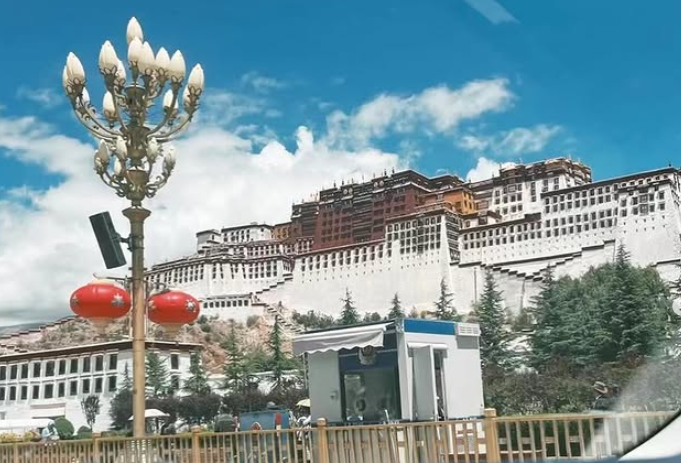The city of Lhasa rises like a sanctum suspended between heaven and earth in the center of the Tibetan Plateau, where the air thins and the light shines with extraordinary sharpness. It has maintained a strong sense of identity despite political upheaval by upholding centuries of spiritual discipline. With its combination of holy architecture, everyday devotion, and mountain-bound tenacity, Lhasa, long regarded as the “Place of the Gods,” has maintained its position as the cultural and religious center of Tibet since the 17th century.
Lhasa is one of the world’s highest cities, rising 3,656 meters above sea level. However, elevation is more than just altitude. The majesty of the Potala Palace, the spiritual allure of Jokhang Temple, and the serene charm of Norbulingka are the best examples of this city’s strong ties to faith and tradition. In recent years, Lhasa has drawn more and more tourists who are looking for authenticity in a world that is frequently dominated by fast-paced experiences, in addition to pilgrims.
Capital of Tibet – Lhasa
| Attribute | Details |
|---|---|
| Official Name | Lhasa (ལྷ་ས་) — “Place of the Gods” |
| Founded | 633 A.D. by Tibetan King Songtsen Gampo |
| Current Status | Capital of Tibet Autonomous Region, Chengguan District, China |
| Population | Approximately 279,000 (as of 2010) |
| Altitude | 3,656 meters / 11,990 feet |
| Notable Landmarks | Potala Palace, Jokhang Temple, Norbulingka, Barkhor Street, Sera Monastery |
| Language and Identity | Primarily Tibetan, with Chinese influences; strong religious culture |
| Source Link | Tibet Travel Guide , Instagram , Wikipedia |
Lhasa’s Development: From Goat Pastures to Sacred Streets
Lhasa was known as Rasa, a small grazing area that meant “Goat’s Place,” long before it became a spiritual epicenter. However, everything changed when King Songtsen Gampo made this the location of his capital and built the Jokhang Temple, laying the groundwork for the city that would grow to be extraordinarily sacred. As its significance grew, Lhasa’s name changed, evolving from a place for herding fields to a haven of knowledge and enlightenment.
As borders and empires changed over the ages, Lhasa remained remarkably unwavering in its purpose. Millions of Tibetan Buddhists turned to it as their spiritual home and the Dalai Lama’s residence. Its ascent was deeply cultural, spiritual, and symbolic in addition to being geographical. Despite the stresses of modern life, Lhasa still seems like a gateway to a timeless world where chanting monks, prayer wheels, and incense smoke are commonplace.
A City Filled with Ritual and Honor
When strolling down Barkhor Street, one engages with Tibetan life rather than merely witnessing it. While locals navigate alleys lined with vendors selling hand-carved amulets, butter lamps, and coral beads, pilgrims bow down in rhythmic devotion. The district as a whole exudes an extraordinary sense of vitality, where community, business, and spiritual energy coexist harmoniously.
The way that Lhasa blends spiritual depth with everyday life is what makes it so incredibly special. While ancient texts reverberate within temple walls, locals enjoy yak butter tea in serene courtyards. Acts of reverence on a daily basis create a calm harmony here. Additionally, this experience gives visitors a sense of rootedness in a world that is continuously changing—something that few other locations on Earth can match.
The Architecture of Lhasa as Evidence of Its Function
The Potala Palace dominates the skyline, its golden roofs and white walls shining brilliantly in the morning light. It is still a soaring symbol of Tibetan pride and tenacity, where the Dalai Lama once resided. Going there is more than just a tourist experience; it’s an emotional journey that reunites tourists with the spirit of a people who have held onto their beliefs over centuries of change.
Sera Monastery and the Norbulingka Summer Palace are nearby and provide more subdued but still very immersive experiences. In candlelit halls, novices recite ancient mantras while monks argue ancient philosophy with forceful hand slaps. These establishments are active hubs of scholarship, devotion, and thought rather than just monuments.
The city’s sacred foundations hold the key to its future
Lhasa is anticipated to play a bigger role in discussions about sustainable tourism, cultural preservation, and geopolitical nuance in the years to come. Its elevation provides a stunning viewpoint for considering the harmony between tradition and modernity, both literally and figuratively. Although the extent of China’s influence in the area is still up for debate, it is certain that Lhasa’s spirit continues to beat on its own, propelled by centuries of unwavering faith.
Even with the advent of paved roads, high-speed internet, and foreign tourists, Lhasa’s heartbeat is still distinctly Tibetan. The city’s steady, timeless, and focused spiritual rhythm endures despite the modernization of markets and the expansion of buildings.
A Dynamic Compass in a Changing Environment
The inquisitive, the loyal, and the idealists are still drawn to Lhasa. Its energy is grounded, deliberate, and incredibly multi-layered rather than frantic or ostentatious. In addition to simply observing, it encourages visitors to stop, think, and observe a way of life that is still influenced by holy cycles.


